 Defining A True Pocket Pistol
Defining A True Pocket Pistol
Updated: December 31, 2009
How do YOU define a "pocket gun?" Obviously, this is a very subjective thing, and people will have a variety of opinions. For example, I found this comment on an internet forum:
"For some reason, people like to take compact firearms and try to claim that they are pocket guns. You want a test: here is one. Go into a gun store wearing jeans. Take a gun and put it into your rear pocket. If it can be totally concealed in your rear pocket, then you have found a pocketgun. If a little of it peeks out, then you have a small gun, but not a pocketgun...My personal test as to what is a pocket gun and what is not, is the guns ability to be fully concealed in the rear pocket of a pair of slacks."
Someone else said: "My definition of a pocket gun is one that can actually be carried in,and drawn from, the pocket effectively in public, not merely being able to fit in one's pocket."
There are some who say they are able to conceal a full-size 1911 handgun in their pocket. I don't believe it. On the other hand., by strict definition, a pocket gun is any gun that will fit in a pocket. That's pretty broad and inclusive!
Here's a link to "flyandscuba's" collection of pocket pistols (photos and comments).
"Oldgranpa" wrote an interesting "blog" about pocket pistols, their history, and their effectiveness. I'm going to copy and paste it right here. It is good reading!
We are so fortunate in this country that our founding fathers were inspired to include the 2nd Ammendment in our Bill of Rights. We are fortunate that the Supreme Court of our land chose to uphold the 2nd Ammendment on two occasions recently. Most of our States include laws protecting the right of honest, God fearing citizens for self defense using firearms if necessary. Along with that, reliable firearms have been produced by excellent manufacturers. Quality ammunition has been developed that provides the level of self defense needed against lawless felons.
So why "pocket" pistols? The life style of America has changed dramatically. In our father's days business men wore suits or a sport coat. Ladies wore full dresses or business suits. A full size handgun could be concealed under such clothing easily. Popular then and somewhat now were the 1911 .45's and Browning or Beretta 9 mm's. You're out of style anymore wearing a suit, except in some snob environments. The shoulder holster won't work. Elliot Ness is no longer the norm. Sport clothes are the fashion today. Hanging your shirt out to conceal a IWB pistol is OK while off duty, but most places you go the shirt stays inside the belt. The only thing left is a deep pocket. In a few cases an ankle holster is used, which is just plain uncomfortable, to me at least.
Oddly enough, the big pistols were not first on the list. Before John Browning, handguns were mainly Colt revolvers with the .45Colt cartridge, 1873. Then the Stevens Co. produced the .22LR rimfire with smokless powder, 1887. Browning's first was NOT a .45. In 1899 he invented the .32acp. Followed by the .38special in 1902 by Smith&Wesson. In 1903, Colt started making .32acp pistols. The European 9mm Luger appeared around 1904. Then in 1906, Browning made the .25acp and .380acp.
Military requirements for a larger caliber saw the Browning .45 in 1910 and it was given the name the "1911" in the year that Colt started making the famous Browning .45. By then the .380 was the popular police pistol in Europe.
Other calibers started to appear after that. The .357magnum in 1935, Makarov 9x18 in 1950, the ..44magnum in 1955, the .22WMR (.22magnum) by Winchester in 1960, etc. etc. The country of Belgium mass produced the Baby Browning .25acp around 1940 and was available for $35 in the USA. It became the "SaturdayNiteSpecial" responsible for hundreds of homicides until banned around 1968 for import.
Fads, like the "One-Shot-Stop" made it seem a big handgun was the only way to go. The 1911 .45 was readily available after WWII and became a top choice to get that mythical one-shot-stop. We all wanted one. Or a 9mm, choice of many police departments after Glock came out with his light weight, polymer framed pistol. Still needs at least a IWB holster to carry, even the smaller G19 model. A fine, reliable pistol, even today. Way too big for my pocket.
Then, around 1973, a little home business produced a tiny pistol, the SeeCamp .32acp. (The Seecamp .32 could only use SilverTip JHP ammo, worthles ballistics.) NAA immediately tried to copy it with their Guardian .32, heavy little clunker. A Swedish designer by the name of George Kellgren, who had tinkered with firearms like the Grendel brand, wanted to do something like the GLOCK. In around 1995 he contracted with a CNC machine shop in Cocoa, Florida to produce a polymer framed .32acp pistol he designed, and Kel-Tec was born. Lighter than the Seecamp or NAA, it's sales soared. None of these .32's had ballistics to even remotely produce a one-shot-stop, but with a full magazine and rapid fire could easily discourage a felon.
When, exactly the small .380's came on the market, I'm not sure. Kel-Tec just up-sized their P32, left off the slide lock, and had success with the P3AT, 1st gen. model. Seecamp made one and so did NAA. Now the market is flooded with 380's, some of them pure junk. But the pocket gun craze has made sales of all these pistols, many with polymer frames, soar.
In 1986, the famous Miami Shootout occured, resulting in all kinds of ammo testing, etc. etc. You can search the web for all kinds of reports, reviews, summaries on this event. Ammo testing still goes on today on all calibers. The magic bullet has yet to be found. But the gelatin testing that came out of it set us on the right track. Substitute ballistic tests, like my wetpack tests, have also added to the data base.
The bottom line? Well, as a result we even have today ammo that makes the little .380 pocket pistol a formidable weapon. So now we can carry a nice little feather-weight pocket pistol with some degree of confidence. As civilians, we rarely will have to shoot through barriers or angle shots at a felon. Face-on at close range we can aim for COM and keep shooting until we get results. Just be sure your pistol of choice is 100% reliable, and you've tested your ammo of choice, and know it fires every time. My hope is we'll never need it. But in today's world, who knows. Like my friend Norf says, "have a gun."
Thanks, OG!
My (Mousegunner's) personal definition of a pocket gun ties in with the guns usefulness as a concealed weapon. Many a large gun can be stuffed into a pocket. But it will be noticeable, because of its size, thickness and weight.
I define a genuine pocket gun as one that will comfortably fit into a man's front pants pocket, not be uncomfortably heavy so as to shift around a lot while walking, and not be noticeable to the general public. I believe these criteria rule out anything that is larger, thicker and heavier than a GLOCK 26 (9mm) or 27 (40S&W). This is just my personal definition, and of course you are welcome to your own opinion!
There is a "thread" on the Keltec Owners Group forum in which P-11 owners are discussing whether they think the P-11 is just a tad too much for pocket carry.
Here's a picture of a Kel-Tec P3AT and P-11 together. As you can see, the P-3AT is quite a bit smaller. However, the P-11 CAN work as a pocket pistol. It is just a little bit smaller than the GLOCK 26/27.
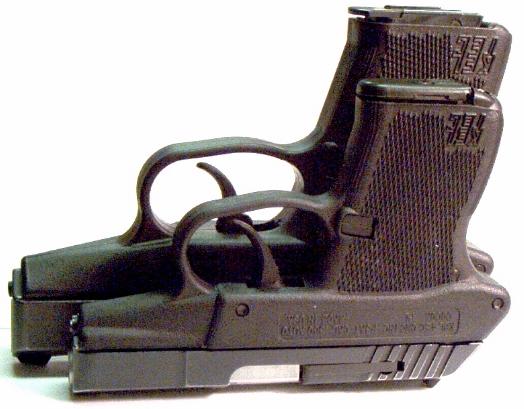
Here's a photo comparing the GLOCK 27, Kel-Tec P11, Kel-Tec PF9, and Kel-Tec P3AT.

And here is another photo with the weights of the fully loaded pistols. The GLOCK 27 has nine rounds of 165 grain 40 S&W; the Kel-Tec P11 is loaded with eleven rounds of 115 grain cartridges; the PF9 has eight rounds of 115 grain each; the P3AT has seven rounds of FMJ .380 ammo.

The Kel-Tec PF-9 (see my review) is just a bit lighter and thinner than the P-11, and works better as a pocket pistol. However, the capacity of the PF-9 is only 7 + 1. The PF-9 is 5.85 inches long, 4.3 inches high, and .88 inches thin. It weighs 12.7 ounces empty. It is said to be the flatest and lightest 9mm pistol available. I sometimes carry one in my pocket, and in my opinion it is an excellent pocket pistol. It is light, thin, and not very expensive (under $300). If you have plenty of funds, then you may prefer the Kahr PM9 ($650), or the Rohrbaugh 9mm pistol ($950). For about $500 you can get a GLOCK 26 or 27.
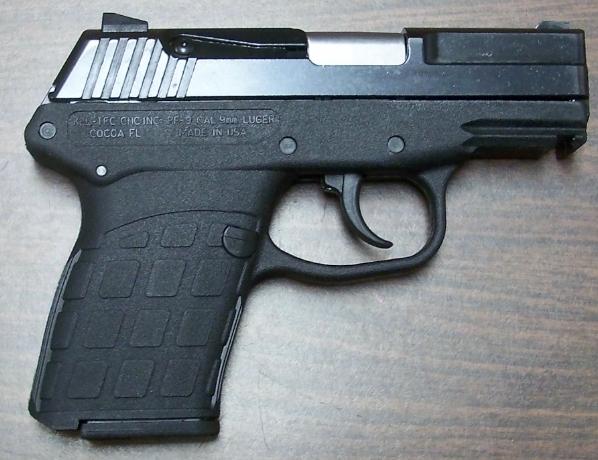
Here is a page of photos comparing the sizes of the P-11 and the PF-9.
Here is a drawing to illustrate the sizes of a few popular semi-automatic pistols that may be carried as pocket guns. The measurements are in inches and are not perfectly accurate to the nth degree, but close enough for a visual comparison.
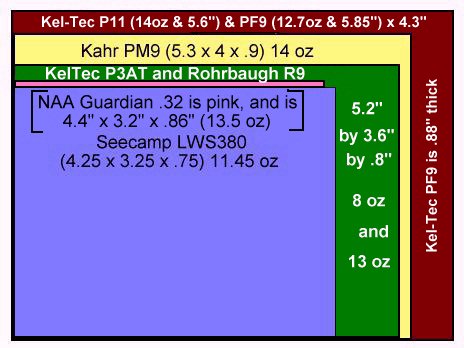
Here's a photo of my Kel-Tec P-11. If a gun is much larger than a P-11, then I don't see how it can be easily used as a pocket gun. My P-11 weighs 21 ounces (according to my postage scale) fully loaded with 11 rounds of 9mm ammo.
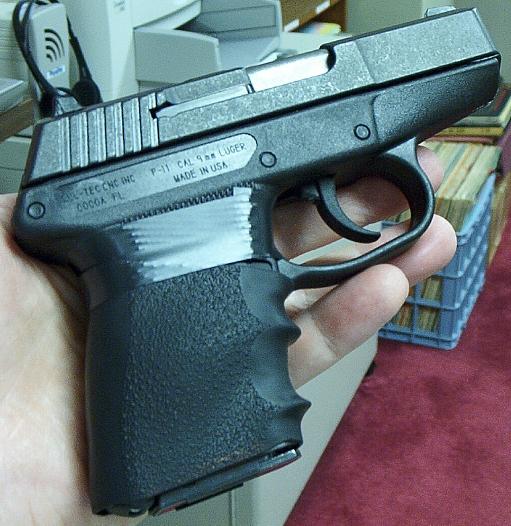
You will see from the drawing that the Kahr PM9, is somewhat smaller (and a bit thinner) than the Kel-Tec P-11. This would make it more of a true pocket gun. I don't own a PM9 (yet!)
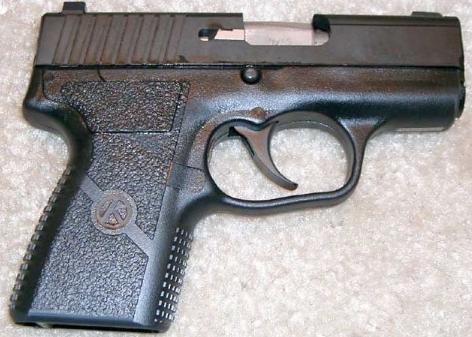
The PM9 has a capacity of only 7 rounds, versus 11 rounds for the Kel-Tec P-11. So, subtracting the weight of four rounds of 9mm ammo, a fully loaded PM9 must weigh in the neighborhood of 19 ounces.
There are a few handguns even smaller than the Kahr PM9, and here we enter the realm of undeniable pocket pistols. The Kel-Tec P-3AT (.380ACP) and the Rohrbaugh R-9 (9mm) are nearly identical in size.
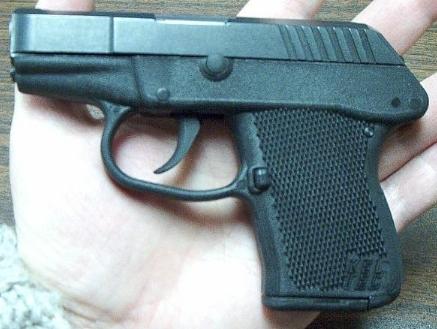
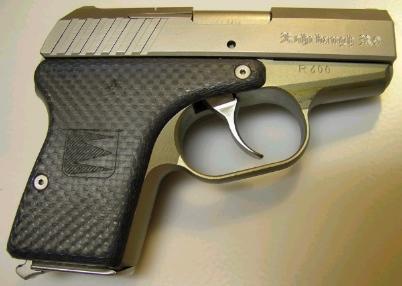
My 1st generation P-3AT weighs about eight ounces, and around eleven ounces fully loaded. I am told that the 2nd generation P-3AT weighs about an ounce more. The Rohrbaugh weighs 12.8 ounces, and around 15 ounces fully loaded. The R-9 is the most "pocketable" 9mm pistol in existence, and the extra weight will probably not make it more uncomfortable than the P3AT, if a good pocket holster is used. The firepower advantage of 9mm over .380 must not be overlooked.
The Kel-Tec P-3AT has an older, smaller brother, the P-32. Their sizes are very nearly identical, but the P-32 weighs about an ounce less, and shoots the smaller, lighter .32ACP caliber round. Of course, it would be better to use at least a .380 caliber bullet for self-defense.

The smallest .380ACP semi-auto pocket pistol is the Seecamp LWS380, which is only 4.25 x 3.25 x .9. The weight (11.45 oz unloaded) is a bit more than the Kel-Tec P-3AT, but less than the R9, and not unmanageable.
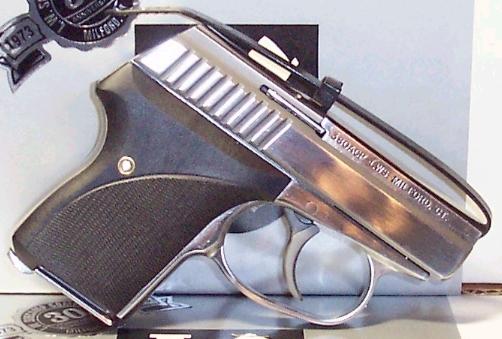
With a pistol this small, it is important to have a pocket holster that will fill out your pocket, hide the outline of the gun, and keep the gun from rotating around in your pocket. You wouldn't want to reach for your gun in trying circumstances and come up holding the slide instead of the grip!
Speaking of "hiding the outline" of the gun, here's a photo of my Kel-Tec P-11 in my pocket.
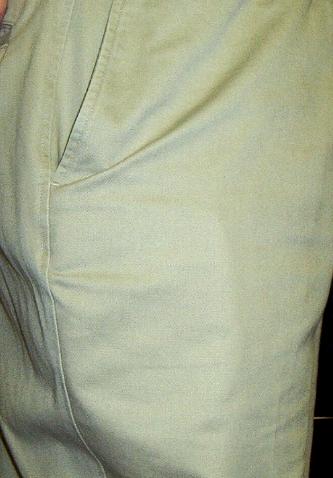
The "print" of the gun shape should be hidden by whatever you use for a holster. You can make your own, or buy one of the many brands on the market. An excellent "holster" for most pocket guns is the half-unzipped gun rug that comes with the Kel-Tec P3AT.
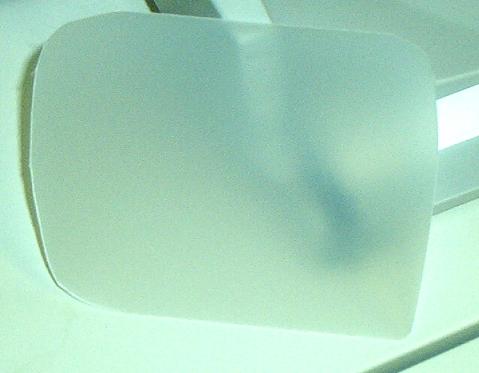
North American Arms makes some neat little revolvers: the Black Widow, the Mini-Mag, and so on, that are true pocket guns. These little guns shoot either .22 or .22 magnum cartridges. Usually they come with two swappable cylinders.
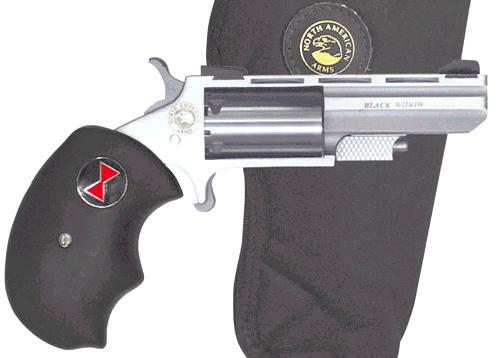
North American Arms also makes the semi-auto Guardian pistols in .32ACP, .380ACP and .32NAA. These are very nice firearms. The .32 Guardian is 4.4 inches long, 3.2 inches high, and only .86 inches thick. It weighs only 13.5 ounces. The .380 is a bit larger and heavier (18.7 ounces).
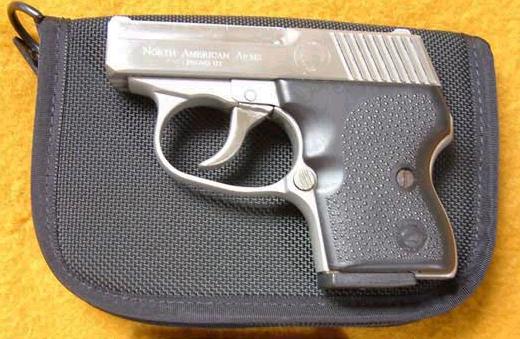
The Beretta Tomcat is a popular .32ACP pistol. It measures 4.9 inches long, 3.7 inches high, and 1.1 inches thick. It weighs 16.9 ounces.
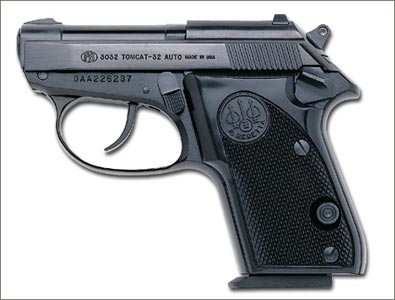
There are also those who claim that Smith and Wesson Ultralight J-frame revolvers can be pocket guns. Some of them are definitely light enough. For example the 342PD Airlite Titanium weighs only 11 ounces, and carries five .38 special cartridges. However the 342 PD revolver is 6 5/16 inches long and about 1.3 inches thick. This is quite a bit larger than a Kel-Tec P-11!
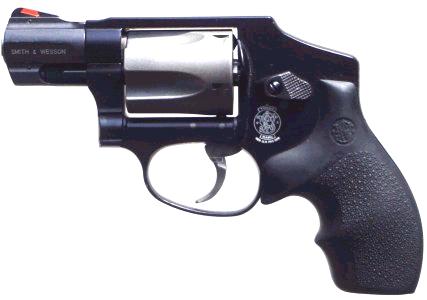
By the way, Gunblast.com has a great review of the S & W 342PD, with lots of photos. Click here to read it.
There are also a number of .25ACP pocket pistols available, such as the Raven, the Baby Browning the NAA Guardian.
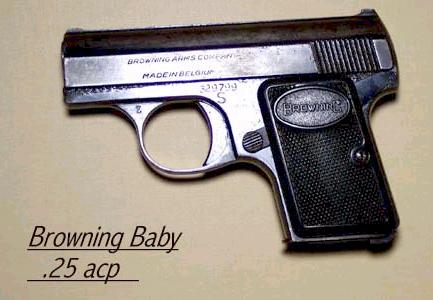

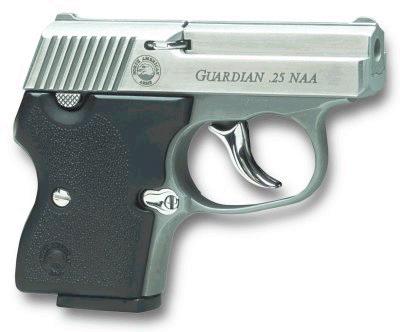
Finally, let's not forget the "Derringers." The one or two cartridge pistols that have been around for over 100 years. They are small and come in all calibers.
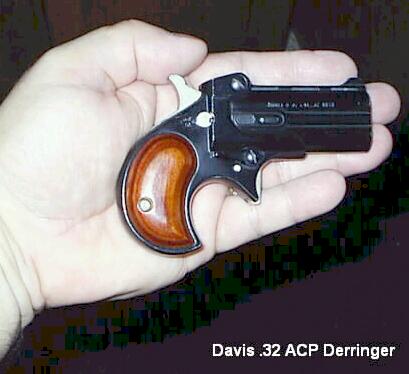
My personal choice for the ideal pocket gun has changed over the years. When I first started carrying a pistol I prefered the Kel-Tec P-3AT. Over the years I've tried Kel-Tec PF-9 and P-11 Pistols, and even a GLOCK 27. Now I'm back to the KeKel-Tec P-3AT. It is the right size/weight, and affordable. The others are just too large, too heavy, or too expensive to be comfortable in my front pants pocket. The year 2009 produced some P-3AT clones which are probably just as good (Kahr and Ruger, for example). But the Kel-Tec is a long-proven design, and costs less money than the others. The Kel-Tec P-32 is even lighter than the P-3AT, carries one more round, and would be an excellent choice. As yet, I have not acquired one.
My present "back up" pistol, in case my P-3AT should get "lost" or need to return to the Kel-Tec factory for fixing, is a Jimenez J.A. 25. It is a very inexpensive gun (I paid $109.99 for mine last year). It shoots .25 ACP ammo, and holds six rounds. It has proven to be reliable, too.
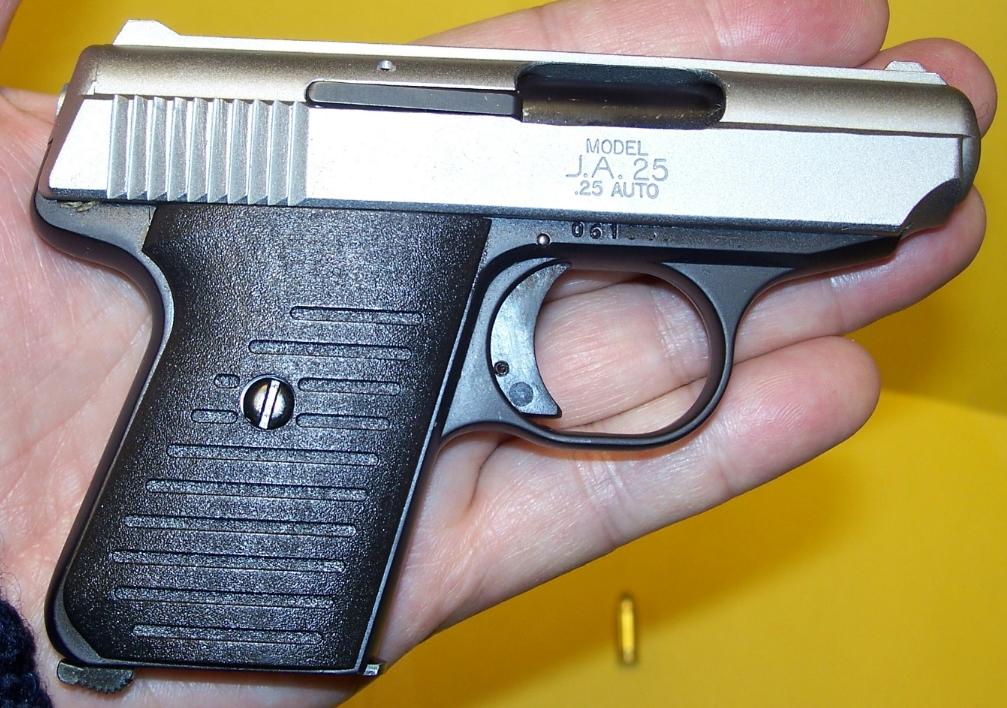
"Bobo" from "The High Road" and other gun forums has made a fantastic chart featuring 16 different pocket guns with photos and specifications. Here is the link to the pdf file.























